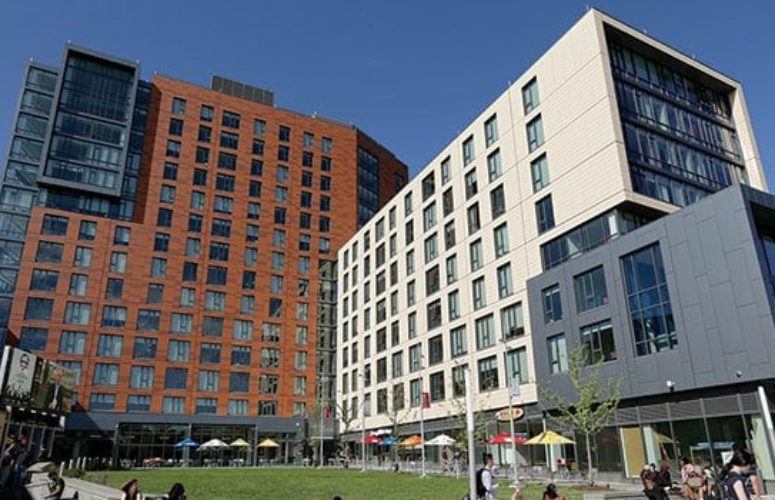
In New Jersey, Construction is Strong in Array of Sectors
There is work to be had in a variety of leading business and institutional sectors in the state.
By Jim Pytell, Assistant Editor On May 1, 2017The construction trades continue to find themselves doing work in many leading business and institutional sectors throughout the state. A plethora of universities and hospitals are expanding and renovating, providing ample opportunities for the trades to have work. Additionally, the need for commercial real estate is as vital as ever, as consumer demand is driving the industrial/warehouse sectors, while businesses seek to renovate existing office spaces to meet their 21st century workforce needs.
“Like most of the country, our members are seeing substantive growth in almost every sector in 2017, both public and private, which is really the first time since the recession ended,” Jack Kocsis, CEO of the Associated Construction Contractors of New Jersey (ACCNJ), says. “One telling point: construction is now at 4 percent of the state’s GDP – maybe not the 5 percent it was before the recession, but definitely an important part of New Jersey’s economy.”
He adds that New Jersey stands out as somewhat unique in the sense that sectors that stand to slow across the country, such as retail stores and multi-family housing and mixed-use development, do not stand to do so in New Jersey.
“Retail has picked up, which is interesting, because some of the big retail names like Macy’s and JC Penney are closing stores, but not so much in New Jersey. Warehousing and data centers, which were strong last year, will continue to be a growth sector this year. Office building, a sector that lagged for a long time because of high vacancy rates in existing buildings, is finally picking up. Multi-family housing and mixed-use development, while expected to slow across the country, remains a strong sector in the state. Healthcare construction is still evident in the big healthcare systems across New Jersey, as they expand their services into offsite specialty care and emergency clinics,” he says.
“With the huge residential growth that we are seeing come across the river from New York City, you have to have things here to support the incoming residents like restaurants, entertainment, grocery stores and retail,” says Alan Golub, president of Modern Electric Co.
Golub points to the transformation of the Jersey City skyline as a perfect example of the commitment to creating high end real estate that’s temptingly close to the Big Apple. Notably, the Journal Squared complex in Jersey City that, upon completion, is set to feature 1,800 apartments over three different skyscrapers – the smallest of which will stretch 53 stories with the others reaching 60 and 70.
“We’ve seen a lot of construction within the higher education community, not just within our jurisdiction, but all over the state,” Bernie Corrigan, president of IBEW Local 102, says. “Rutgers continues to grow and Rowan University has made great use of public/private partnerships to elevate its status as one of the fastest growing campuses in New Jersey.”
Recently completed at Rutgers University was The Yard @ College Avenue, which is the newest student residential complex at the school. It is an on-campus, 220,000-square-foot, 442-bed apartment-style building for students. In addition to approximately 15,000 square feet of service retail space, it features a green lawn with a 350-square-foot high definition video board.
“Montclair State University has completed some nice projects, and has some new buildings and renovations going on right now. Its business school, The Feliciano School of Business, is a six-story, 143,000-square-foot structure that was completed in 2015. The building is a centerpiece on campus, featuring Spanish Mission architecture and state of the art facilities,” Corrigan says. “Some of their current projects include the School of Communication and Media, Mallory Hall and Partridge Hall.”
“One very exciting project is taking place at the old Hoffman-LaRoche property on Route 3. Seton Hall University and Hackensack Meridian Health have partnered to build a new school of medicine on the former biomedical campus. Straddling the towns of Clifton and Nutley, we look for the new medical school to be a catalyst for more development in the coming years,” Corrigan adds.
In addition to the Hoffman-LaRoche campus redevelopment, IBEW Local 102 has worked closely with a number of real estate firms that are working on several major projects across the state, including the NJ Center for Excellence in Bridgewater.
Kevin McCabe, president, Carpenters Contractor Trust of New York and New Jersey, says that on the manufacturing side, the effects from the port project widening and the expansion of the Bayonne Bridge are beginning to be seen, not only with the construction of new warehouse space and distribution centers, but also with the expansion of existing ones.
“In my mind, these warehouses for distribution are the shopping centers of the 21st century,” Golub says. “With people increasingly shifting to online shopping, goods are being distributed through these warehouses as opposed to people going to the malls.”
Joe Stark, president of Star-Lo Electric Inc., says, “We are doing a lot of solar [panels] right now, particularly for Amazon and its new distribution facility in Carteret.”
He adds that many companies are becoming increasingly eco-conscious with the use of LED lights, which is providing the electric companies with plenty of work opportunities. For example, Star-Lo Electric is currently working on retrofitting the New York Giants training facility with long lasting and energy efficient LEDs.
Overall, building construction in New Jersey is healthy, and that trend is poised to continue into 2017 and beyond.
Moving forward, McCabe emphasizes the importance of utilizing all of the assets that New Jersey has to offer, including academic institutions which are second to none – and bringing people in from the private sector who are on the front lines.
“We need to ensure that we have leadership,” he says. “The leadership at the state and local levels [needs to] work with the private sector to [come up with] a plan that is going to allow for greater economic development – not just for tomorrow, but for next week and the years to come.”
Related Articles:






